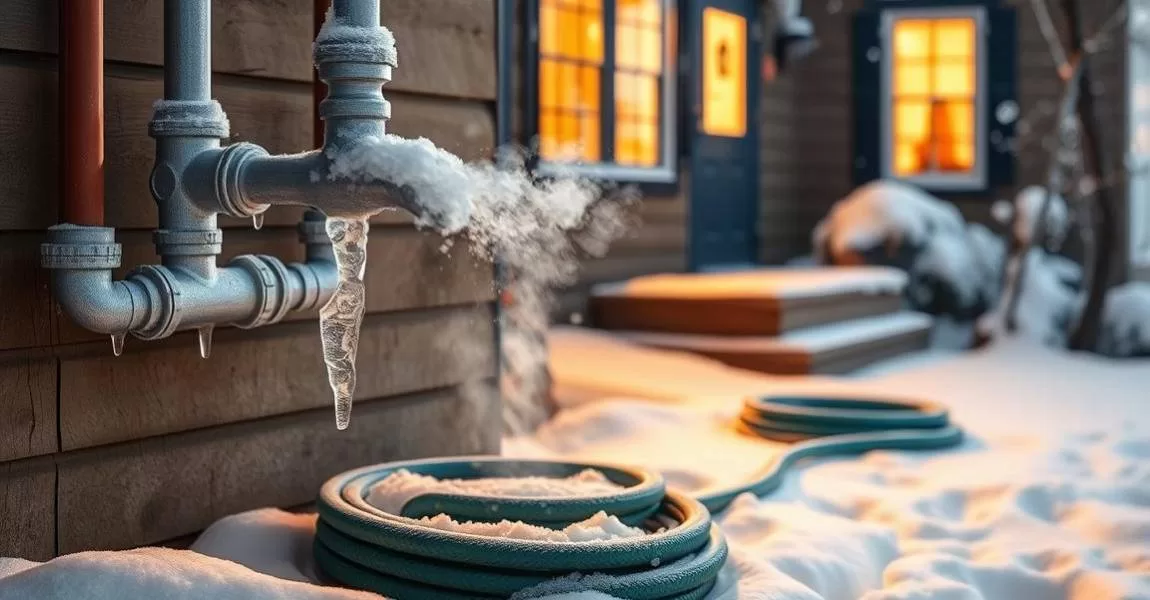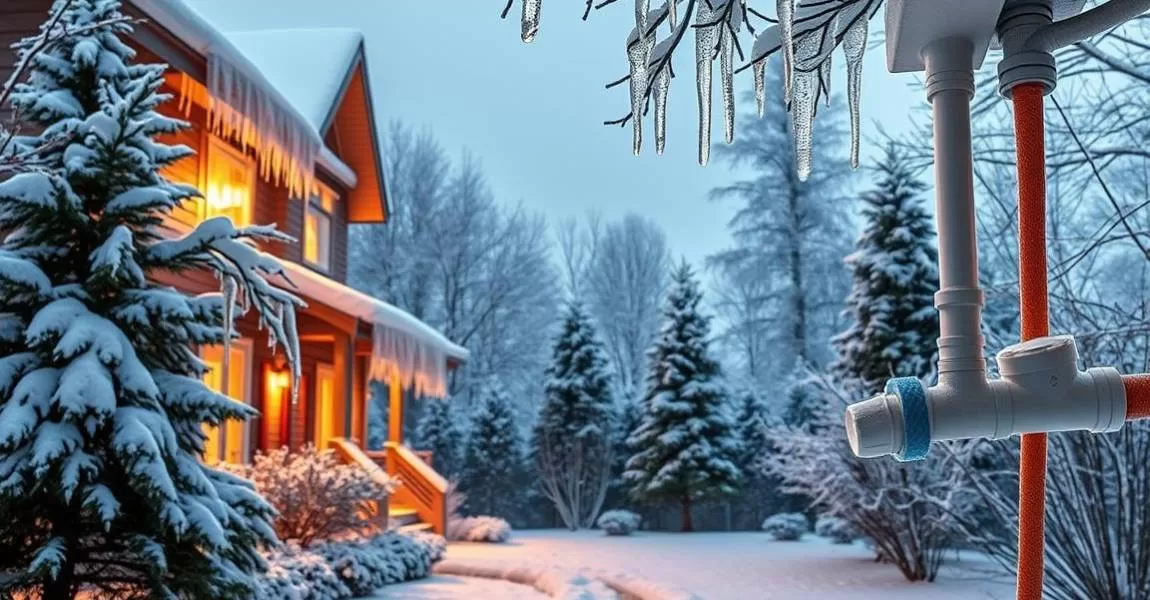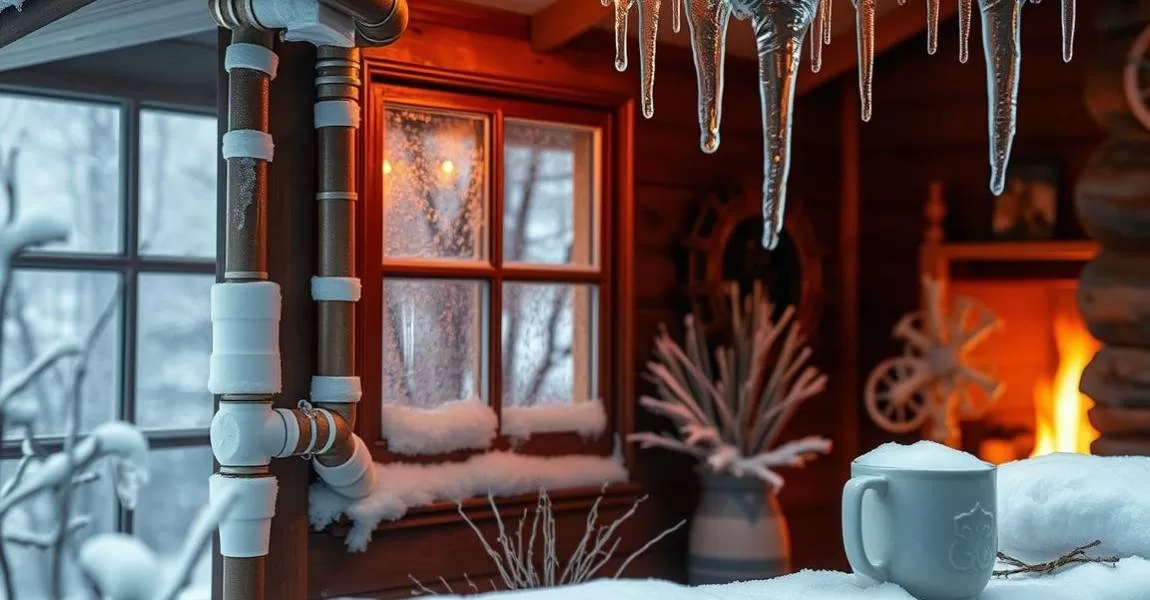Every year, 250,000 homes in the U.S. face frozen pipe damage, costing billions. To avoid this, homeowners in cold places like Colorado can take steps to prevent frozen pipes. This includes insulating pipes, sealing cracks, and letting faucets drip.
Understanding water control for frozen pipes is key. It helps protect your home from frozen pipe risks. By insulating, sealing, and dripping faucets, you can avoid costly repairs.

This article will show you the benefits of water control for frozen pipes. You’ll learn how to prevent frozen pipes in your home. By following these tips, you can keep your pipes safe and your home warm all winter.
Key Takeaways – Water Control Tips
- Implementing water control for frozen pipes can help prevent costly repairs and damage to your home.
- Insulating your pipes is a critical step in preventing frozen pipes.
- Letting cold water drip from faucets served by exposed pipes can help prevent frozen pipes.
- Sealing any cracks or gaps in your home can help prevent cold air from reaching your pipes.
- Effective water control for frozen pipes can help you avoid the hassle and expense of dealing with frozen pipe damage.
- Proper water control can help you protect your home and ensure it remains safe and warm during the winter months.
Table of Contents
Understanding the Risks of Frozen Pipes in Colorado
If you own a home in Colorado, you know about the dangers of frozen pipes. Cold weather can make pipes freeze, leading to expensive damage. To learn how to prevent frozen pipes, it’s key to know why pipes freeze. This includes bad insulation and poor installation.
Places like unheated basements and crawl spaces are most at risk. Insulating these areas and protecting your pipes can lower the chance of freezing. This way, you avoid the high costs of emergency frozen pipes solutions. The damage from frozen pipes can cost thousands of dollars.
- Insulate exposed pipes in unheated areas
- Seal any cracks or gaps in your home’s foundation
- Let cold water drip from faucets served by exposed pipes
By following these tips and taking steps to protect your pipes, you can lower the risk of frozen pipes. This helps you avoid the need for expensive repairs.
Essential Water Control for Frozen Pipes Prevention
To stop frozen pipes, it’s key to act early. Use pipe insulation for frozen pipes to keep pipes warm. Wrap pipes in foam in cold spots like basements or garages.
Also, disconnect and drain outdoor hoses. This stops water from freezing in these spots.
For thawing frozen pipes safely, be careful not to damage them more. Use a hair dryer or heat lamp, but safely. Follow the rules to avoid shock or fires.
Check your home’s foundation for gaps or cracks. Seal them to keep cold air out and pipes from freezing.
- Letting cold water drip from the faucet served by exposed pipes
- Opening cabinet doors to allow warm air to circulate around pipes
- Setting the thermostat to a consistent temperature
By following these tips, you can prevent frozen pipes. This saves you from expensive damage. Always thawing frozen pipes safely to protect yourself and your plumbing.
Smart Pipe Insulation Techniques
Keeping pipes from freezing is key to avoiding burst pipes. Insulating exposed pipes in cold spots like garages and basements is important. This helps in winter pipe maintenance.
There are many insulation materials, like foam and heat tape. Foam is easy to use and works well. Heat tape is pricier but can stop pipes from freezing.
Different Types of Pipe Insulation Materials
- Foam pipe insulation
- Heat tape
- Reflective insulation
Choosing between professional or DIY insulation depends on your preference and budget. Professional installation might cost more but lasts longer. DIY options are cheaper but require careful following of instructions and safety.
Priority Areas for Insulation Installation
Focus on areas most likely to freeze, like pipes in unheated spaces. Insulating these spots lowers the risk of burst pipes. Regular checks can catch problems early, saving you from costly repairs.
Implementing Effective Winter Pipe Maintenance
How to Prevent Freezing Pipes & fix them:
In Colorado, dealing with cold water management is common. To keep your pipes from freezing, you need good winter maintenance. Letting cold water drip from faucets is a helpful tip.
Opening cabinet doors under sinks is also key. It lets warm air in and keeps pipes from freezing. You can also use foam or heat tape to protect exposed pipes. Don’t forget to disconnect and drain outdoor hoses to prevent freezing.
Some top tips for winter pipe care in cold places like Colorado include:
- Regularly check pipes for damage or wear
- Properly drain and store hoses and outdoor gear
- Let cold water drip from faucets served by exposed pipes
- Open cabinet doors under sinks to let warm air in
By following these tips, you can avoid the trouble and cost of frozen pipes. Keeping your pipes safe is vital for your home’s safety during winter.

In Colorado, harsh winters mean you must watch your pipes closely. With the right steps and awareness of the climate’s challenges, your pipes will stay safe and working all year.
| Winter Pipe Maintenance Tips | Benefits |
|---|---|
| Let cold water drip from faucets | Helps prevent pipes from freezing |
| Open cabinet doors under sinks | Allows warm air to circulate and helps keep pipes from freezing |
| Disconnect and drain hoses | Helps prevent water from freezing in outdoor faucets |
Advanced Water Monitoring Systems
Protecting your home from frozen pipes is key. Advanced water monitoring systems can help. They detect leaks and frozen pipes early, preventing damage. Water alarms are a big part of these systems, alerting you to problems.
Modern tech offers many solutions for water control for frozen pipes. Smart water detection systems watch your water use in real-time. They can spot leaks or frozen pipes. You can even monitor your home’s water use from anywhere.
Benefits of Advanced Water Monitoring
- Early detection of leaks and frozen pipes
- Remote monitoring options for added convenience
- Customizable alerts and notifications to keep you informed
Advanced water monitoring systems give you peace of mind. They include water alarms and smart detection. This helps prevent damage and saves money.
Emergency Response to Frozen Pipes
Discovering a frozen pipe is a serious issue. You must act fast to avoid more damage. Frozen pipes prevention is good, but in emergencies, you need to know what to do. First, turn off the main water shut-off valve to stop water flow to the frozen pipe. Next, open the faucets to drain water from the pipe, reducing pressure and preventing it from bursting.
For emergency frozen pipes solutions, consider these steps:
- Call a professional plumber if you’re not comfortable dealing with the situation yourself
- Use a hair dryer to thaw the pipe, but be careful not to apply too much heat, which can cause the pipe to burst
- Apply heat to the pipe using a towel soaked in hot water or a heating pad
Remember, frozen pipes prevention is key. But if you face an emergency, stay calm and take the right steps. Being prepared and knowing what to do can protect your home and property from frozen pipe risks.

It’s also important to note that emergency frozen pipes solutions may vary. This depends on the situation’s severity and specific circumstances. If unsure, it’s best to seek professional help.
Professional Solutions and When to Call an Expert
Dealing with frozen pipes can be tricky. Knowing when to call a pro is key. If you see severe water damage or a burst pipe, act fast. Experts can offer pipe insulation for frozen pipes and safely thaw frozen pipes to avoid more harm.
Choosing a licensed plumber is important. Here’s what to look for:
- Check their license and certification
- Read reviews and ask for referrals
- Get multiple quotes and compare prices
While DIY fixes can help, experts are usually the best choice. They ensure your pipes are well-insulated and thawed correctly. If you’re not sure what to do, don’t hesitate to call a professional.
Conclusion: Protecting Your Home Through Proper Water Management
Keeping your pipes in good shape during winter is key to avoiding costly repairs. By following the tips in this article, you can prevent frozen pipes. This ensures your home’s plumbing is ready for Colorado’s cold weather.
Using insulation and water monitoring systems is important. Regular checks and maintenance help prevent frozen pipes. This reduces the risk of emergencies.
Being proactive in winter can save you from the trouble of burst pipes. By focusing on water control, you can protect your home. This way, you can enjoy the winter in Colorado without worry.
FAQ
What are the common causes of pipe freezing?
Pipe freezing can happen due to several reasons. These include not enough insulation, bad pipe installation, and very cold weather. Pipes in places like basements, crawl spaces, and attics are more likely to freeze.
How can I prevent my pipes from freezing?
To stop your pipes from freezing, you can do a few things. First, make sure your pipes are well-insulated. Also, disconnect and drain outdoor hoses. Seal any cracks in your home’s foundation. Lastly, let cold water drip from faucets when it’s very cold.
What should I do if I have a frozen pipe?
If you have a frozen pipe, act fast. First, turn off the main water valve to avoid more damage. Then, try to thaw the pipe with a hair dryer, heat lamp, or other safe method. If it doesn’t thaw or you think it might burst, call a plumber.
What types of pipe insulation are available, and which one is best for my home?
There are many types of pipe insulation, like foam, fiberglass, and heat tape. The best one for you depends on where your pipes are, how cold it gets, and your budget. Getting a professional to install it can help a lot.
How do I know if I need to call a professional plumber for my frozen pipes?
If you see signs like a burst pipe, a lot of water damage, or can’t thaw it yourself, call a plumber. It’s always safer to get a pro, even if you’re not sure about the damage.
What are the benefits of using a water alarm or smart water detection system?
Water alarms and smart systems can warn you early about leaks or frozen pipes. This lets you act fast to prevent damage. These systems can be part of your home’s water system and offer remote access, giving you peace of mind and saving money on repairs.
How can I maintain my pipes during the winter to prevent freezing?
To keep your pipes safe in winter, check them often for damage. Make sure they’re well-insulated. Let cold water drip from faucets when it’s very cold. Use heat tape or wraps on exposed pipes. Also, turn off and drain outdoor faucets and irrigation systems.
Contact Us
At JD’s Plumbing, Heating, and Air Conditioning, we’re here to help you protect your home from frozen pipes. Whether you need expert advice, emergency pipe thawing, or preventative maintenance, our skilled team is ready to assist.
Don’t let cold weather cause costly damage—reach out to us today! Contact us or schedule a service online to keep your plumbing and heating systems running smoothly all winter long.





